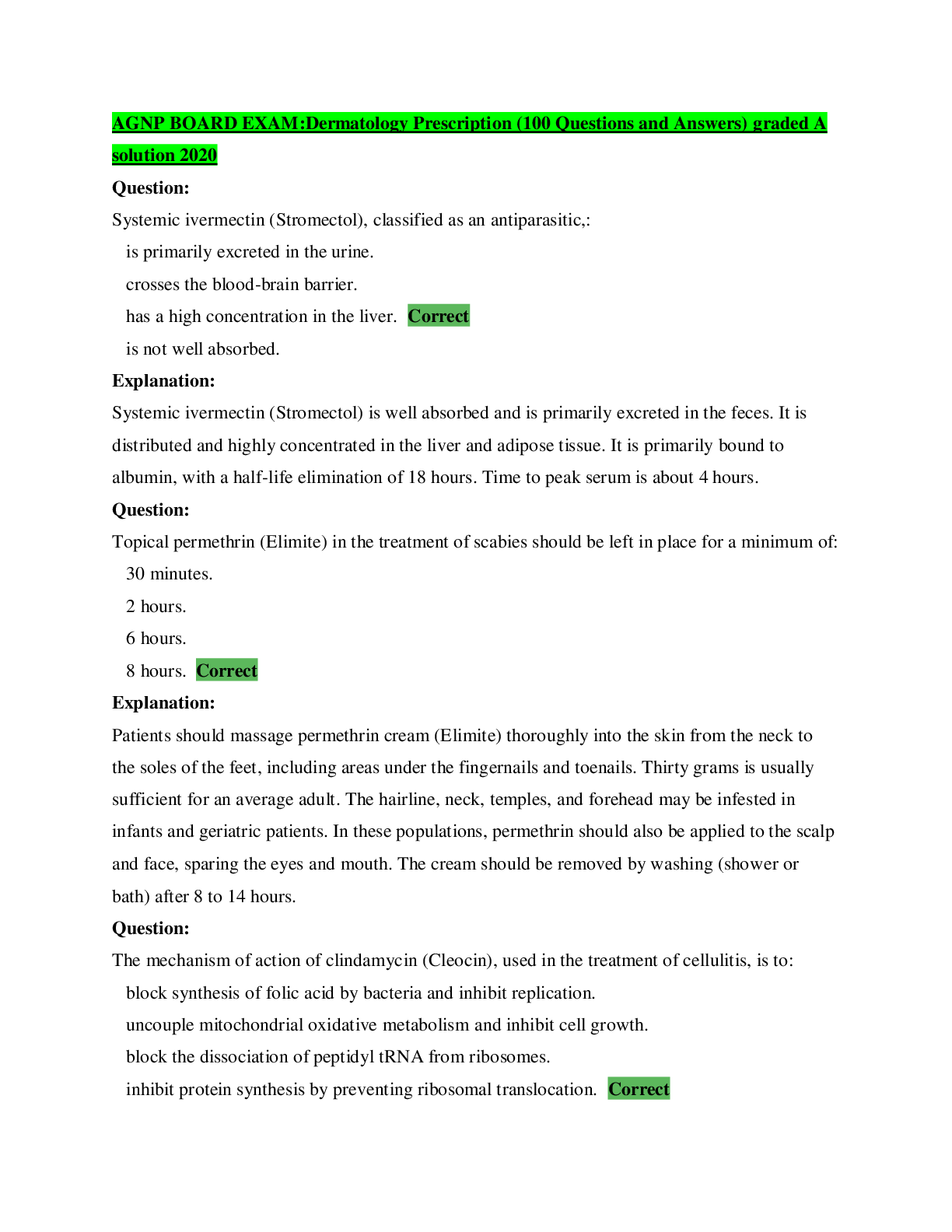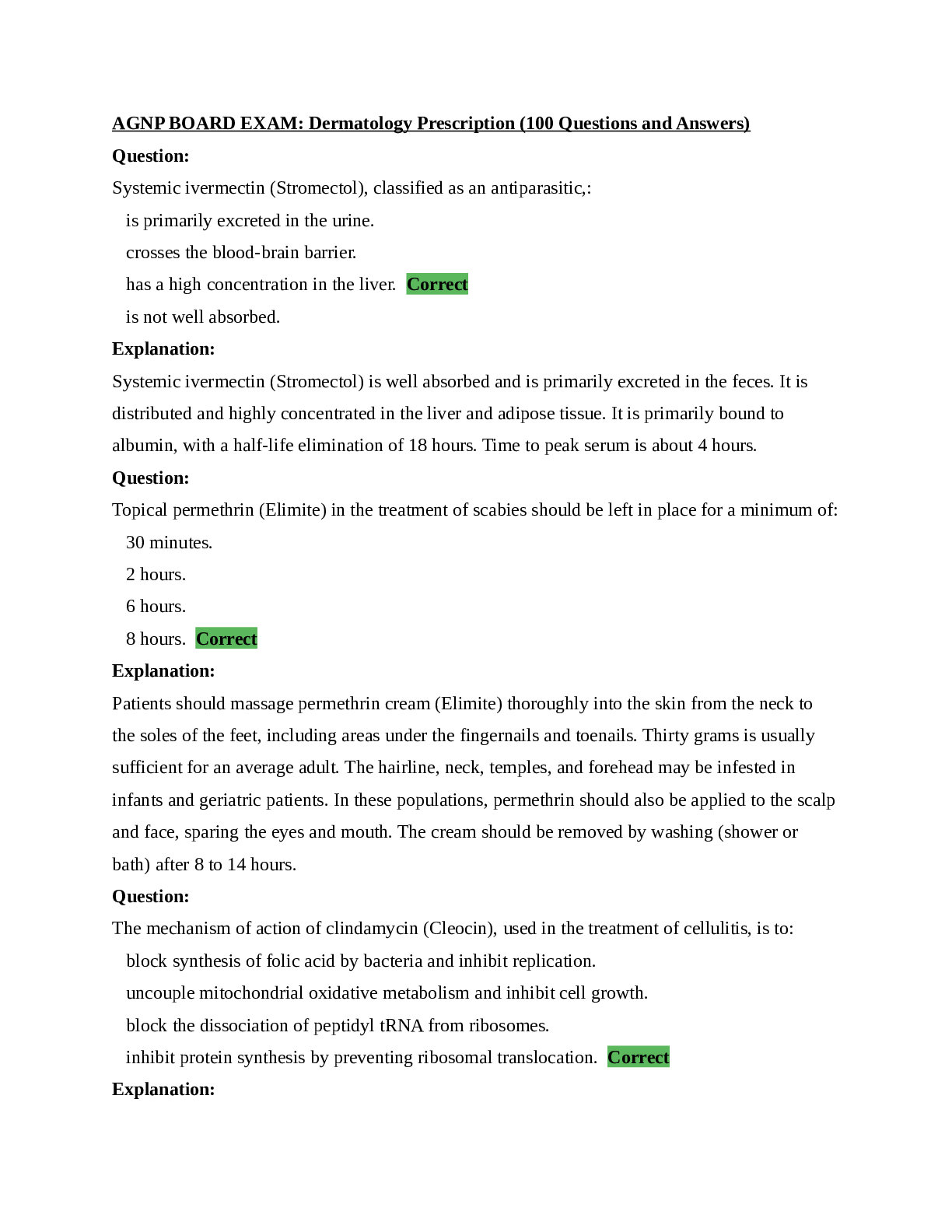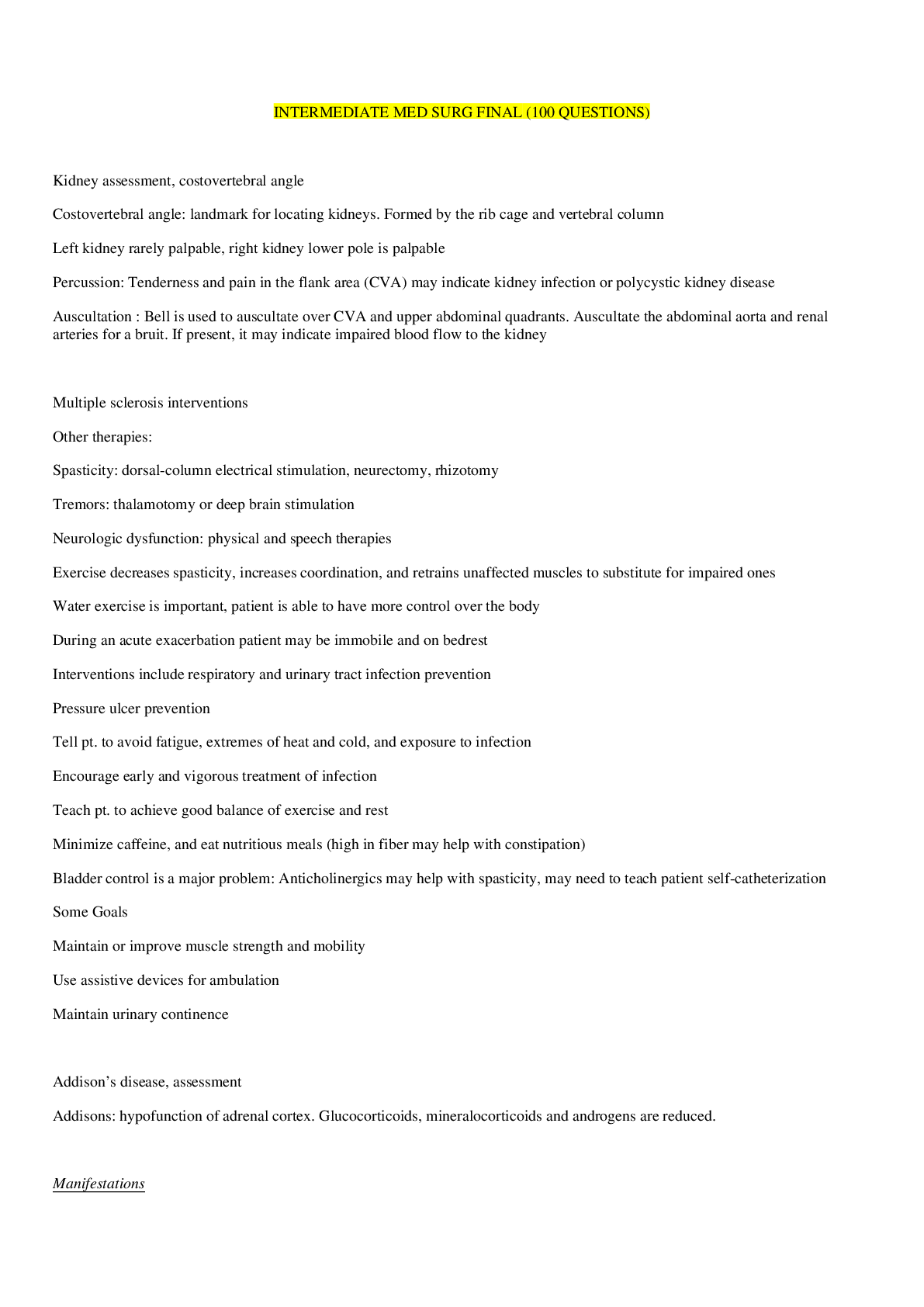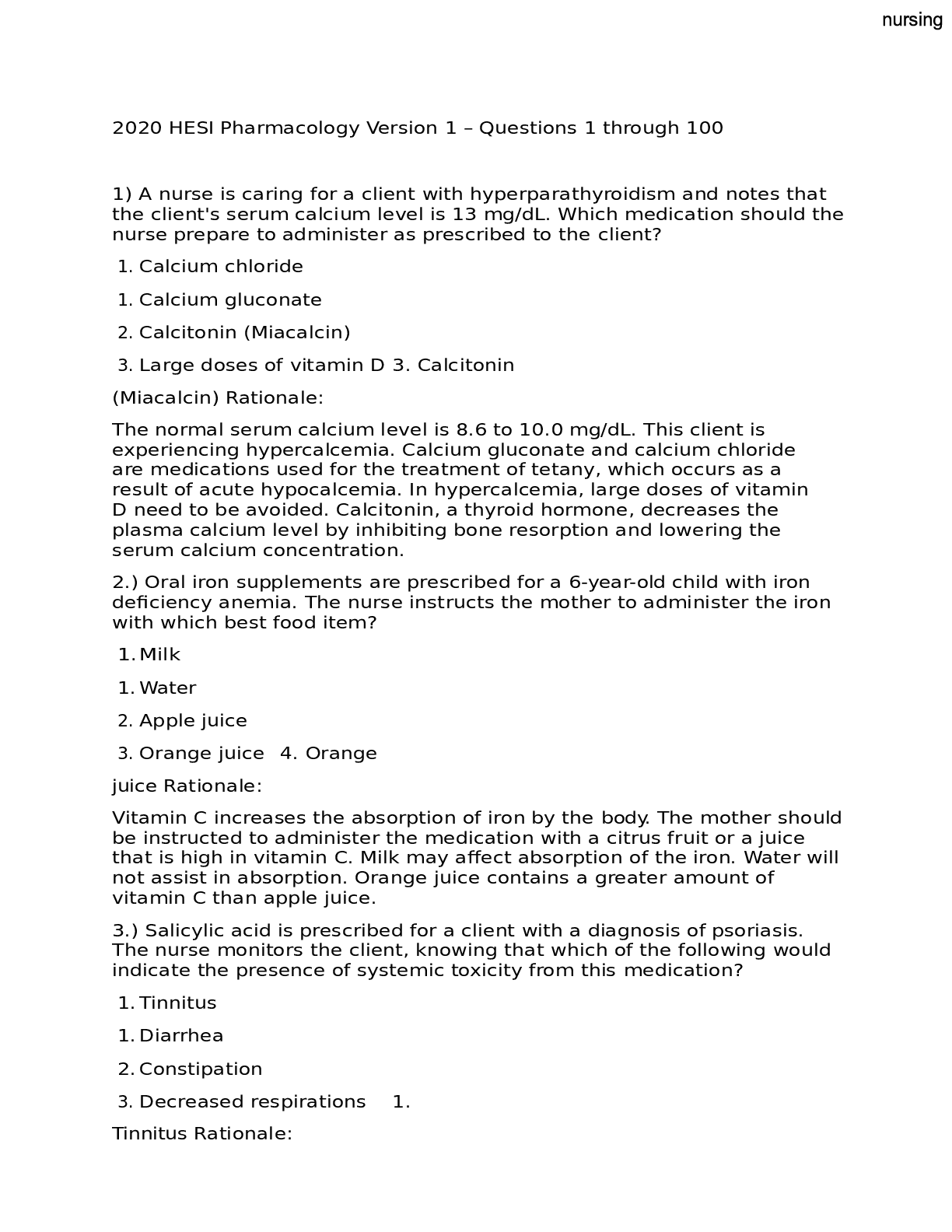AGNP BOARD EXAM: Dermatology Prescription (100 Questions and Answers)
Document Content and Description Below
AGNP BOARD EXAM: Dermatology Prescription (100 Questions and Answers) Question: Systemic ivermectin (Stromectol), classified as an antiparasitic,: is primarily excreted in the urine. cross... es the blood-brain barrier. has a high concentration in the liver. Correct is not well absorbed. Explanation: Systemic ivermectin (Stromectol) is well absorbed and is primarily excreted in the feces. It is distributed and highly concentrated in the liver and adipose tissue. It is primarily bound to albumin, with a half-life elimination of 18 hours. Time to peak serum is about 4 hours. Question: Topical permethrin (Elimite) in the treatment of scabies should be left in place for a minimum of: 30 minutes. 2 hours. 6 hours. 8 hours. Correct Explanation: Patients should massage permethrin cream (Elimite) thoroughly into the skin from the neck to the soles of the feet, including areas under the fingernails and toenails. Thirty grams is usually sufficient for an average adult. The hairline, neck, temples, and forehead may be infested in infants and geriatric patients. In these populations, permethrin should also be applied to the scalp and face, sparing the eyes and mouth. The cream should be removed by washing (shower or bath) after 8 to 14 hours. Question: The mechanism of action of clindamycin (Cleocin), used in the treatment of cellulitis, is to: block synthesis of folic acid by bacteria and inhibit replication. uncouple mitochondrial oxidative metabolism and inhibit cell growth. block the dissociation of peptidyl tRNA from ribosomes. inhibit protein synthesis by preventing ribosomal translocation. Correct Explanation: Sulfa agents block synthesis of folic acid by bacteria and thus inhibit bacterial replication. First-generation cephalosporins inhibit cell wall synthesis of bacteria. Antifungals uncouple mitochondrial oxidative metabolism and inhibit cell growth. Macrolides inhibit bacterial growth, possibly by blocking dissociation of peptidyl tRNA from ribosomes, causing RNA-dependent protein synthesis to arrest. Other antibacterials are bacteriostatic or bactericidal and inhibit protein synthesis by preventing ribosomal translocation. Question: Tretinoin topical (Retin-A) is indicated for the treatment of acne vulgaris and: acne rosacea. dermatomyositis. inflammatory keratosis pilaris. mottled hyperpigmentation. Correct Explanation: Tretinoin topical (Retin-A) is indicated for the treatment of acne vulgaris, palliation of fine wrinkles, mottled hyperpigmentation and facial skin roughness. Question: The brand name of oral isotretinoin is: Duac. Absorica. Correct Accolate. Accupril. Explanation: The brand names of oral isotretinoin include Absorica, Amnesteem, Claravis, and Zenatane. The generic name for Duac is clindamycin/benzoyl peroxide, used in the treatment of acne. The generic name for Accolate is zafirlukast. It is a leukotriene inhibitor used in the treatment of asthma. The generic name for Accupril is quinapril; it is an ACE inhibitor. Question: Benzoyl peroxide (Benzac wash) is classified as a topical: antibiotic. astringent. antimicrobial. Correct acetic acid-based cleanser. Explanation: Benzoyl peroxide is a topical antimicrobial used in the treatment of acne. When applied to the skin, benzoyl peroxide works by reducing the amount of acne-causing bacteria and by causing the skin to dry and peel. Question: The generic name for Elidel is: permethrin. pimecrolimus. Correct tacrolimus. urea topical. Explanation: The generic name for Elidel is pimecrolimus. Elidel is a dermatologic agent used in the treatment of atopic dermatitis. The brand name of permethrin is Nix or Elimite. It is an antiparasitic used in the treatment of lice. The brand name for tacrolimus is Prograf. It is an immunosuppressive drug used after transplant. The brand name of urea topical is Keralac and it is used in the treatment of hyperkeratosis. Question: Which of the following conditions is NOT a side effect of long-term use of topical steroids? Cutaneous atrophy Glaucoma Hypotrichosis Correct Telangiectasia Explanation: Cutaneous and systemic side effects can occur, particularly with super potent and potent drugs, or extensive use of lower potency agents with or without occlusion. Treatment with topical corticosteroids should be restricted to the lowest and shortest duration of therapy required to achieve the desired effect. Cutaneous atrophy, telangiectasia, hypertrichosis, striae, purpura, hypopigmentation, glaucoma, and suppression of the hypothalamic-pituitary axis are side effects that may occur with topical corticosteroid use. Question: Patients using fluorouracil (Carac) for the treatment of actinic keratosis should be advised to expect: hypopigmentation. eczema. pustular formation. vesiculation. Correct Explanation: When fluorouracil (Carac) is applied to a lesion, erythema followed by vesiculation, desquamation, erosion and re-epithelialization occurs. Local reactions and alterations in skin appearance may persist for several weeks after discontinuation. Question: Tetracycline (Sumycin) is used in the treatment of skin and skin structure infections caused by: Bartonella bacilliformis. Klebsiella species. Escherichia coli. Staphylococcus aureus. Correct Explanation: Tetracycline (Sumycin) is indicated for the treatment of skin and skin structure infections caused by Staphylococcus aureus or Staphylococcus pyogenes (commonly found in post burn infections). Question: The most appropriate therapy for patients with chronic paronychia is a: systemic antifungal. systemic glucocorticoids. topical steroid. Correct topical antibiotic. Explanation: Chronic paronychia appears to be an eczematous process that can be complicated by secondary Candida infection. Avoidance of environmental triggers is an essential component of treatment. Patients should wear gloves during wet work and should avoid contact with irritating substances. Topical treatment consists of the application of a medium or high-potency topical corticosteroid. If patients do not improve with these measures, a course of topical antifungal therapy may be combined with topical steroid. ..............Continued [Show More]
Last updated: 2 years ago
Preview 1 out of 38 pages
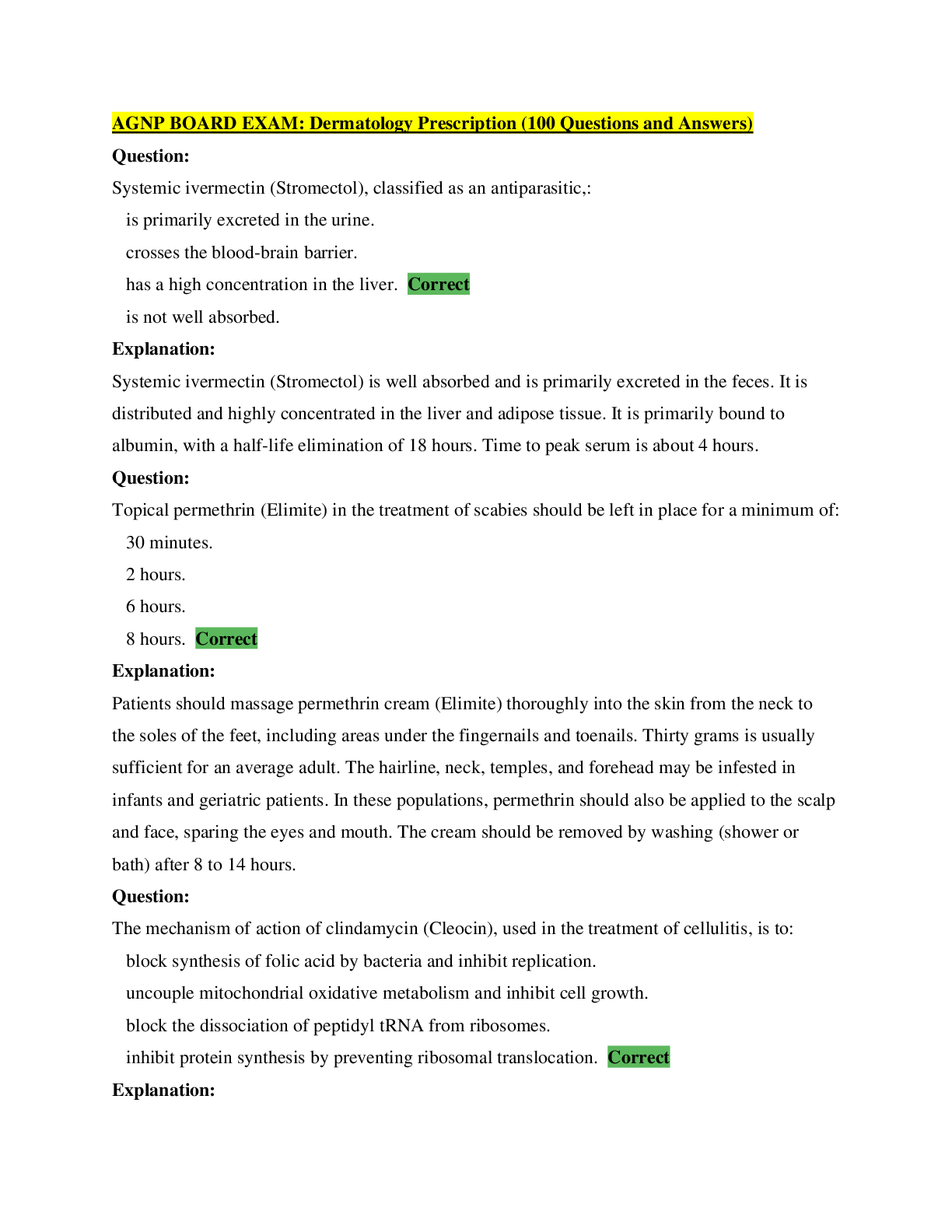
Buy this document to get the full access instantly
Instant Download Access after purchase
Buy NowInstant download
We Accept:

Also available in bundle (1)

AGNP BOARD EXAMS (23 Different Versions) ; Questions and Answers
AGNP BOARD EXAMS (23 Different Versions) ; Questions and Answers
By YourTutor 4 years ago
$95.5
23
Reviews( 0 )
$23.50
Can't find what you want? Try our AI powered Search
Document information
Connected school, study & course
About the document
Uploaded On
Feb 01, 2021
Number of pages
38
Written in
Additional information
This document has been written for:
Uploaded
Feb 01, 2021
Downloads
0
Views
116













 _ Dermatology Prescription (100 Questions and Answers) – South University Savannah.png)
